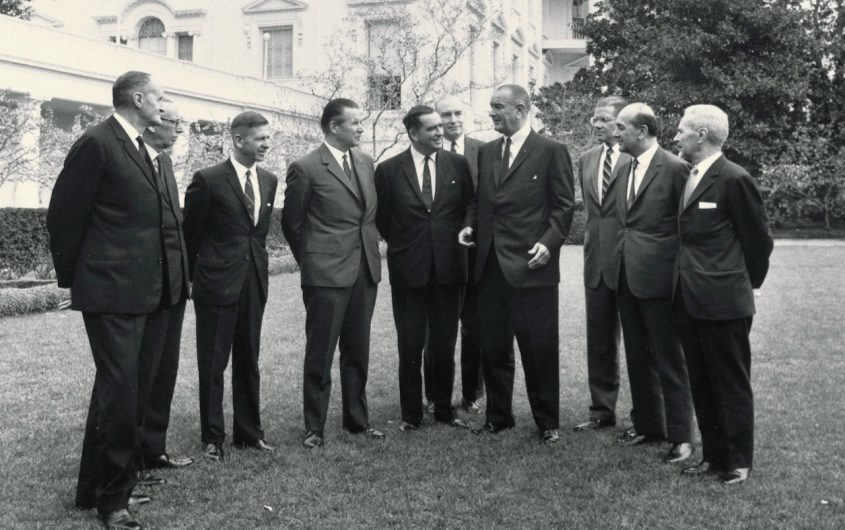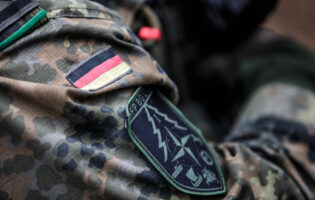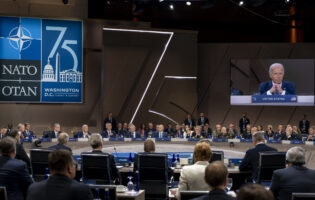
NATO via Flickr
Promoting Integration and Avoiding Isolation. A Brief History of Germany’s Participation in NATO’s Nuclear Statecraft

Stephan Kieninger
Historian
Stephan Kieninger is a historian and the author of two books on the history of détente and Euro-Atlantic security: “The Diplomacy of Détente. Cooperative Security Policies from Helmut Schmidt to George Shultz” (London: Routledge, 2018) and “Dynamic Détente. The United States and Europe, 1964–1975” (Lanham: Rowman & Littlefield, 2016). His current research looks into NATO enlargement and the search for the post-Cold War order. He received his Ph.D. from Mannheim University. Formerly, he was a Postdoctoral Fellow at Johns Hopkins SAIS, a Fellow at the Berlin Center for Cold War Studies and a Senior Research Associate at the Federal German Archives.
Currently, Germany is struggling to decide on a successor for its aging Tornado aircraft. Some of the ancient Tornados are essential to carry forward deployed U.S. nuclear bombs and thus ensure Germany’s continued contribution to nuclear sharing in NATO.
Germany’s Minister of Defense Annegret Kramp-Karrenbauer is determined to place an order for forty-five American-made F-18 jets to replace the old Tornados. Her Social Democratic coalition partners were quick to raise protest. It seems that the left wing of the SPD is willing to abandon Germany’s nuclear sharing role in NATO.[1]
Other Articles On This Topic
This is irrational and would jeopardize the fabric of NATO. Germany’s influence on nuclear matters in NATO would wane. If Germany were to quit, other allies may eventually follow suit. The failure to replace the Tornado could affect the future of arms control in Europe. NATO’s cohesion and Germany’s credibility are at stake. Unilateral disarmament steps won’t bring Russia back to the negotiating table. NATO has to maintain U.S. forward-based systems in Europe and European dual-capable aircraft in order to match Russia’s estimated 2,000 tactical nuclear warheads.
The expectation is that Germany will presumably maintain its contribution to NATO’s burden sharing for the simple reason that the CDU and CSU are committed—and there will be no SPD-led government in the foreseeable future. Nevertheless, the current debate on Germany’s nuclear-sharing contribution sends out shock-waves for political and historical reasons. The NATO allies want to see Germany live up to its commitments. The Federal Republic has to share the financial and nuclear burdens of collective defense and deterrence. Germany’s integration in NATO’s nuclear statecraft is a key element of Euro-Atlantic security.
The 1960s: Nuclear Sharing and Non-Proliferation as Preconditions for Germany’s Ostpolitik
Ever since its inception in the 1960s, Germany’s contribution to NATO’s nuclear sharing has been central to European order and German integration in NATO. During the Cold War, NATO’s extended nuclear deterrence was vital for the Federal Republic’s security. One of Germany’s curses in the second half of the twentieth century was its political geography. During the Cold War, Germany was in a singular position: It was divided and on the frontline of the Cold War, and it could not control its own fate in the case of an all-out nuclear war. It was the only NATO member state certain to be destroyed by its own allies’ nuclear weapons. Hence, the Federal Republic’s nuclear integration in NATO was the best way to participate in NATO’s nuclear strategy decisions and to avoid political “singularization”—that is, to ensure that Germany’s fate would not be isolated from that of its allies and from the rest of Europe.
NATO’s nuclear sharing ties Germany to NATO under U.S. leadership and prevents the emergence of a non-NATO nuclear bloc in Europe.[2] The establishment of NATO’s Nuclear Planning Group in the 1960s gave Germany a greater voice in NATO’s nuclear employment decisions while foreclosing the option of an independent nuclear deterrent.[3] Germany’s involvement in nuclear sharing was the precondition for the conclusion of the Non-Proliferation Treaty in 1968. Germany’s accession to the NPT during Willy Brandt’s chancellorship paved the way for the Federal Republic’s Ostpolitik toward the Warsaw Pact countries. The Federal Republic’s integration in NATO and its nuclear renunciation strategy were the only tolerable safe path for détente and efforts to achieve movement toward Germany’s unification.[4]
The ambition of NATO’s dynamic détente was to lay the groundwork and to articulate a vision under which Germany could be one day reunited without danger to any of its neighbors.
NATO’s 1967 Harmel Report combined deterrence and détente. The ambition of NATO’s dynamic détente was to lay the groundwork and to articulate a vision under which Germany could be one day reunited without danger to any of its neighbors[5]: NATO’s task was “to look to German reunification in freedom, within an integrated Western community.”[6] NATO’s objective was to work for an improvement in the status quo at a time when no ready solution for the German question was at hand. At the same time, a strong NATO defense posture remained essential. In 1974, West Germany’s foreign minister Hans-Dietrich Genscher stressed that “we can’t let NATO be undermined—it is the alpha and omega of our […] security. I believe it is necessary that we look at detente in the proper light. There is no alternative to supporting it, but there is a danger of playing down the threat which exists. I speak frequently of ‘realistic détente’ because the Communist threat must always be kept in mind.”[7]
NATO’s Dual-Track Policy in the 1970s and 1980s: Nuclear Modernization as a Lever for Nuclear Arms Control
In the second half of the 1970s, the Soviet Union’s buildup in SS-20 missiles led to the emergence of NATO’s Dual-Track Decision of December 1979: NATO leaders agreed to deploy new U.S. Theater Nuclear Forces (TNF)—Cruise and Pershing II Missiles—in response to the SS-20s. At the same time, NATO maintained its readiness to continue arms control negotiations with the USSR—in other words, balancing deterrence with détente in these two parallel and complementary approaches. Crafting and implementing the Dual-Track Decision, both military and diplomatic, tested NATO’s cohesion to the limit. Eventually, this mixture of solidarity and flexibility proved to be an essential combination and the solution that ultimately led to the conclusion of the INF Treaty in 1987, resulting in the withdrawal of all intermediate-range missiles in Europe.
Chancellor Helmut Schmidt was among the architects of NATO’s Dual-Track Decision. Starting in 1977, he was among the first Western policymakers to address the need for a modernization of NATO’s TNFs. At the same time, Schmidt argued that the deployment of new Ground-Launched Cruise Missiles and Pershing II Missiles could not be limited to Germany. Such a singularization of West Germany would highlight its political vulnerability.[8] Schmidt was eager to avoid the perception that the Federal Republic could turn into a semi-nuclear power. He argued that “there is already envy on the part of others in Europe of Germany’s economic success. […] There were long memories in Europe and there is fear of German economic domination. […] There were two weak spots for Germany: Berlin and Auschwitz. These will hinder the range of action for the FRG for thirty years.”[9]
From a German vantage point, the simultaneity of TNF modernization and arms control talks was crucial. Deployment and negotiations were intertwined. NATO would not get one without the other. The path to sustainable arms control would begin with an arms buildup. Schmidt’s preference was a zero outcome of the dual-track process, in other words the total removal of Soviet Intermediate Range Ballistic Missiles and no deployment of American TNFs. He saw it as the ideal outcome as it would remove all the Euromissiles rather than simply controlling their growth in balanced ways. Eventually, the Reagan administration adopted Schmidt’s zero-zero approach in November 1981.[10] President Reagan argued that “for us to be successful in arms control the Russians have to see that the alternative is a buildup to match theirs.”[11]
NATO’s dual-track approach facilitated the conclusion of the INF Treaty in 1987. It eliminated an entire category of nuclear weapons and reduced the likelihood of a surprise nuclear strike. However, the INF Treaty triggered an intra-alliance debate over NATO’s Short-Range Nuclear Forces (SNF) with a range below 500 km.[12] Those systems were not included in the INF Treaty. Initially, NATO’s plan had been to modernize its SNF, the Lance: They were needed for deterrence as long as the Warsaw Pact maintained a massive advantage in conventional forces in Europe. After the INF Treaty, NATO sought an analysis of what it needed for its security. German policymakers were concerned about the prospect that the only weapons left in Europe might be stationed in and targeted in East and West Germany. German Minister of Defense Volker Rühe’s phrase “The shorter the missile, the deader the German,” was a dictum in Germany.[13]
German policymakers rejected SNF modernization and instead wanted the Bush administration to respond to Gorbachev’s arms control proposals. The Kohl government was suspected to have neutral tendencies, and Chancellor Helmut Kohl had serious clashes with Britain’s Prime Minister Margaret Thatcher. She argued that “NATO could not be a shell. It had to modernize its weapons, otherwise the U.S. would sooner or later withdraw its troops from Germany.”[14] In August 1989, George H.W. Bush’s National Security Adviser Brent Scowcroft noted that “Germany’s repudiation of the Alliance position on SNF was unprecedented. It threatens the very basis of extended nuclear deterrence—on which the security of NATO and Europe rests—and may also signal stronger pressure from the FRG toward the denuclearization of Europe.”[15]
Finally, NATO’s May 1989 summit brought a comprise on SNF modernization. It delayed modernization and maintained the option for deployment. NATO showed resolve and found a way to be open to Mikhail Gorbachev’s arms control agenda. The solution for NATO’s SNF problem was not in the nuclear field, but in the area of conventional arms control. NATO’s aim was to eliminate the asymmetries in conventional forces as a way to put off the need to modernize its Lance SNF. President Bush used NATO’s May 1989 summit to advance a proposal to cut U.S. and Soviet troops by 20 percent. This would require NATO to make a reduction of about 30,000 troops. The decisive aspect was that it would require the Soviet Union to withdraw roughly 325,000 troops from Eastern Europe. In 1990, there was no longer a need for SNF modernization after the conclusion of the Treaty on Conventional Forces in Europe (CFE) between NATO and the Warsaw Pact. Both sides agreed to abandon their capacities for surprise attacks and large-scale military offensives in Europe.[16]
NATO Enlargement and Germany’s Post-Cold War Integration: Germany has to live up to its Defense Commitments
The end of the Cold War did not resolve Europe’s security issues. Germany was still NATO’s vulnerable frontline state. NATO’s post-Cold War enlargement freed Germany of its precarious position. Germany sat no longer alone on NATO’s eastern border. NATO enlargement kept the United States engaged as a European power while giving the Federal Republic stability on its Eastern borders and reinsurance against a volatile Russia. The larger NATO projected stability beyond its immediate borders as one central pillar of a new Euro-Atlantic community. In March 1993, German Minister of Defense Volker Rühe was the first ministerial-level official to argue that NATO should open its door to aspiring candidates in Central and Eastern Europe.[17]
NATO enlargement kept the United States engaged as a European power while giving the Federal Republic stability on its Eastern borders and reinsurance against a volatile Russia.
During the Cold War, extended nuclear deterrence was essential for West Germany’s security. Today, extended nuclear deterrence is still important for Germany’s security, but it is absolutely crucial for many of Germany’s Eastern neighbors on the frontline with Russia. Poland, Romania and the Baltic countries want Germany to modernize its dual-capable aircraft as a clear sign of solidarity in NATO. If Germany failed in this endeavor, these countries might ask the United States for the deployment of forward based nuclear weapons on their territories in the not too distant future. NATO’s deterrence and defense posture would change in fundamental ways. Poland and Romania could be tempted to take unilateral measures, setting a dynamic in motion which could end up putting a lot of pressure on NATO’s self-imposed limitations not to deploy nuclear weapons or station troops in Central and Eastern Europe under the NATO-Russia Founding Act of 1997. Thus, Germany’s abandoning of its nuclear sharing commitment could potentially undermine stability and security in Europe.
[1] See Rafael Loss, “Germany, the Tornado, and the Future of NATO,” European Council on Foreign Relations, April 30, 2020.
[2] See William Alberque, The NPT and the Origins of NATO’s Nuclear Sharing Arrangements, Proliferation Papers, No. 57, Institut français des relations internationals (Ifri), February 2017, see https://www.ifri.org/sites/default/files/atoms/files/alberque_npt_origins_nato_nuclear_2017.pdf.
[3] See NATO’s Document Edition “NUCLEAR PLANNING GROUP. The First Meeting of the NPG6, 7 April 1967 Washington, D.C., see https://www.nato.int/nato_static_fl2014/assets/pdf/2020/3/pdf/200305-50Years_NPG.pdf . For an introduction, see https://www.nato.int/cps/en/natohq/news_174160.htm.
[4] See Thomas A. Schwartz, Lyndon Johnson and Europe. In the Shadow of Vietnam (Cambridge, MA: Harvard University Press, 2003).
[5] See Stephan Kieninger, Dynamic Détente. The United States and Europe, 1964–1975 (Lanham, MD: Rowman & Littlefield, 2016).
[6] Memorandum Owen to Rusk “European Security Conference,” 7 May 1966, in: National Archives and Record Administration (NARA), College Park (MD) Records of the Department of State, Record Group 59 (RG 59), Policy Planning Council, Subject and Country File, 1965–1969, Entry 5026, Lot 72 D 319, Box 313.
[7] Memorandum of Conversation Ford, Kissinger and Genscher, 26 September 1974, in: Gerald R. Ford Presidential Library, Ann Arbor (MI) National Security Adviser, Memoranda of Conversations, 1973–1977, Box 6, https://www.fordlibrarymuseum.gov/library/document/0314/1552808.pdf, accessed 11 May 2020.
[8] See Kristina Spohr, The Global Chancellor. Helmut Schmidt and the Reshaping of the International Order (Oxford: Oxford University Press, 2016).
[9] Memorandum of Conversation Brzezinski and Schmidt, 3 October 1978, in: Jimmy Carter Presidential Library, Atlanta (GA), National Security Affairs 7, Box 33.
[10] See Strobe Talbott, Deadly Gambits. The Reagan Administration and the Stalemate in Nuclear Arms Control (New York: Alfred A. Knopf, 1985); Leopoldo Nuti, Frederic Bozo, Marie-Pierre Rey, Bernd Rother (Eds), The Euromissile Crisis and the End of the Cold War (Stanford, CA: Stanford University Press, 2015).
[11] Memorandum of Conversation Reagan and Schmidt, 21 May 1981, in: Ronald Reagan Presidential Library, Simi Valley (CA), Executive Secretariat, NSC, Subject File, Reagan Memcons, Box 48.
[12] See Mary E. Sarotte, 1989. The Struggle to Create Post-Cold War Europe (Princeton: Princeton University Press, 2009); Timothy Andrews Sayle, Enduring Alliance. A History of NATO and the Postwar Global Order (Ithaca: Cornell University Press, 2019).
[13] Volker Rühe, in: Die Welt, 25 April 1987. Rühe debate the issue with Margaret Thatcher at the time. He rejected SNF modernization arguing that the Lance SNF short range “would cover a zone including Weimar, which symbolized Schiller and Goethe and the heart of Germany.” “That is Warsaw Pact,” Thatcher responded in shrill voice. “Unfortunately, we are both right,” Rühe said. Author’s Email Exchange with Volker Rühe, May 14, 2020.
[14] Memorandum of Conversation Kohl and Thatcher, 20 February 1989, in: The National Archives, Kew, Prime Minister’s Office Files, PREM 19, Vol. 2697, see https://www.margaretthatcher.org/document/212213, accessed 16 April 2020.
[15] Memorandum Scowcroft to Bush “Dealing with the Germans,” 7 August 1989, in: George Herbert Walker Bush Presidential Library, College Station (TX), Brent Scowcroft Collection, USSR Chron Files, SNF Files, 91120-004, Soviet Power Collapse in Eastern Europe – SNF – May 1989 [1].
[16] See Kristina Spohr, Post Wall Post Square. Rebuilding the World after 1989 (London: Harper & Collins, 2019).
[17] See Volker Rühe, “Shaping Euro‐Atlantic Policies. A Grand Strategy for a New Era,” in: Survival, Vol. 35, No. 2 (Summer 1993), 129–137; Volker Rühe, “Opening NATO’s Door,” in: Daniel S. Hamilton and Kristina Spohr (Eds), Open Door. NATO and Euro-Atlantic Security after the Cold War (Washington, DC: Brookings Institution Press, 2019), 217–233.









